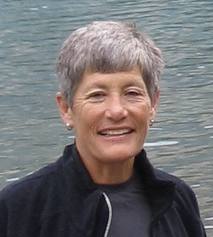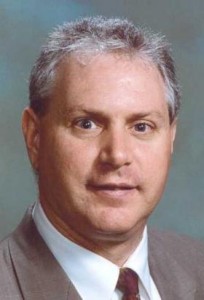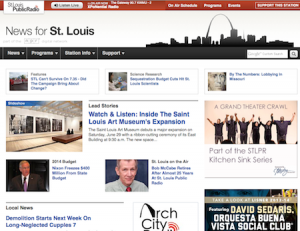If all goes as hoped, in coming months St. Louis Public Radio (SLPR) and the St. Louis Beacon will formally merge their two newsrooms. It will be the first time a public radio station with a staff of journalists has combined its operations with another daily-news producing outlet.
This is not an easy thing to do. For one, St. Louis Public Radio is owned by the University of Missouri’s Board of Curators, and top university officials must sign off on the deal. For another, both the Beacon and the station have strong brands, their own sponsors, their own content management systems, their own organizational charts – not to mention their own definitions of news and ways of producing it.
“We have the beginning of a blueprint of how to create a vigorous news organization that serves a region…”
Yet both parties are convinced it is the right thing to do. Their supporters seem to agree. “We know in the first five years there will be a $3 million revenue gap. After five years, we see sustainability,” said Tim Eby, general manager of St. Louis Public Radio. “We already have $2.5 million of that pledged.”
“If we get it right,” said Beacon founding editor Margie Freivogel, “We have the beginning of a blueprint of how to create a vigorous news organization that serves a region and takes advantage of the assets of public media. I think it’s a very important possibility.”

Just as St. Louis is a city that is trying to re-invent itself, so are its media outlets. The Beacon is a $1.4 million operation with a staff of 18, 14 of whom are reporters. St. Louis Public Radio has 12 people producing news in its $6 million operation.
“I think Tim realized, ‘I need a much stronger news and content engine,'” said Freivogel, a former editor at the St. Louis Post-Dispatch. “He could see that he could build that one person or two people at a time. This is an opportunity to bring 18 people into his organization. That brings a lot of strength.”
For her part, Freivogel knew the Beacon needed to build more revenue generation into its operations.
![]() In moving from the idea of an alliance, announced in the fall of 2012, to a full-bore merger, the two organizations commissioned a study of what they were actually doing on their websites.
In moving from the idea of an alliance, announced in the fall of 2012, to a full-bore merger, the two organizations commissioned a study of what they were actually doing on their websites.
“What we saw was the opportunity was huge,” Freivogel said. Both could improve what they were doing and deliver in-depth coverage of “things no one else is doing very well.”
And they could give their news and information broader reach. For one thing, SLPR has the pipes; the Beacon does good reporting but it shows up in text and social media. SLPR’s website is mostly expanded radio stories.
They concluded that nothing short of full integration – one newsroom, one business operation – would allow them to take full advantage of the opportunities.

Tim Eby
But the process is not without angst. “What do we call ourselves? How do we brand ourselves? Do we lose the Beacon name? That’s scary for us.” Freivogel said. “We’re very proud of what we have done. But we truly want to morph into something new, and we want people to know that it is something new.”
Eby acknowledges, “We know it’s not going to be easy. Just understanding the language of what we do compared with what the Beacon does, we have to be very intentional with how we are going to do this.”
Although the two organizations share Washington, D.C., stories and Beacon reporters do on-air debriefs for SLPR, things got more serious last year when SLPR moved into a new University of Missouri-St. Louis building in Grand Center, the heart of the city’s arts and cultural scene. It was also right next door to the Beacon’s offices at the public television station, the Nine Network of Public Media, which also collaborates with the Beacon but is not part of the merger plans.
Then when WWNO public radio in New Orleans announced it was exploring an expanded collaboration with The Lens in the summer of 2012, Eby said, “Well, if it could happen there, why not here?”
 Once SLPR and the Beacon signed the letter of intent in October 2012, they sought help making it happen. They got $40,000 from the Knight Foundation to pay for Rusty and Janet Coats of Coats2Coats to help them sort through content, vision, revenue plans, technical and branding issues and governance. Working groups of staff members and board members participated.
Once SLPR and the Beacon signed the letter of intent in October 2012, they sought help making it happen. They got $40,000 from the Knight Foundation to pay for Rusty and Janet Coats of Coats2Coats to help them sort through content, vision, revenue plans, technical and branding issues and governance. Working groups of staff members and board members participated.
NPR is also working with SLPR to come up with solutions around its content management system. “We may be the guinea pig,” Eby said.
While there will be some cost savings in the merged operations, no layoffs are expected. “The whole objective of this is to have more reporters and editors,” Eby said. “The biggest thing for us is really establishing ourselves as a place to be producing meaningful content on broadcast as well as digital platforms.”
“Don’t expect coverage of crime or the Cardinals,” he said. Instead, they plan a disciplined focus on politics, education, science and technology, health care, the economy, race, and arts & culture.
For now, the parties are walking the plans through the university system, where some officials have expressed interest in adding an academic program around the merged newsrooms. The prospective partners are now “working intensely” on investigating academic opportunities that would align with a merger, Freivogel said. “The biggest thing,” Eby said, “is to make sure we can get this done in a timely fashion” and keep those donors who have stepped up, informed of the progress.
Underlying the mechanics of the merger, however, is a different vision for what is news and how to engage the community. Already the Beacon has partnered with community groups that news outlets don’t normally partner with to cover such issues as obesity and the role of arts as a regenerator of community.
“Our job,” Freivogel said, “is to talk about what’s going on. What’s working and what’s not working.”






